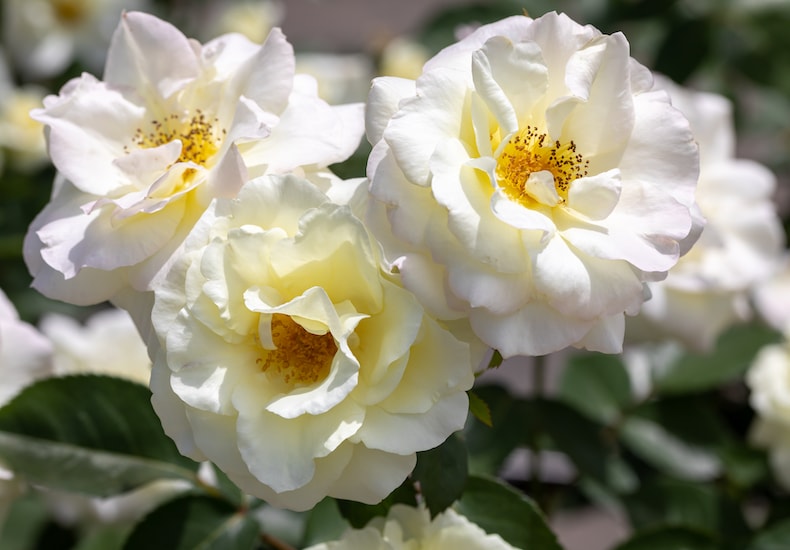
How to prune roses
It's important to prune roses to keep them healthy and vigorous. Although it can sound daunting, with different 'rules' for different varieties, it's worth remembering that roses are tough and will bounce back even if you cut them back quite hard. Read Mandy Bradshaw's expert advice on how to prune your roses like a pro...
Browse our full range of rose shrubs to find the best variety for your garden.
When to prune roses

Most types of roses, like this climbing rose, are pruned in the winter
Image: Rose 'Peter's Persica' (Climbing Patio) from Thompson & Morgan
Apart from ramblers and some shrub roses, the best time to prune is a frost-free day between November and March. You’ll need sharp, clean secateurs and, possibly, long-handled loppers. The aim is to create a pleasing overall shape, while improving the air circulation around the plant to help prevent disease.
How to prune different types of roses

Shrub roses flower on old wood so need only light pruning to rejuvenate the plantr
Image: Rose 'Easy Elegance Macys Pride' from Thompson & Morgan
For all types of rose, start by removing dead, damaged and diseased growth and any stems that are rubbing against another branch. Cut to a strong, outward-facing bud. Then, depending on the variety you have, here are some simple guidelines to follow:
Rambling roses: Vigorous ramblers flower once a year (around June) on the current season’s growth. Cut them back in summer after flowering, removing some of the old growth completely so the rose is gradually rejuvenated.
Climbing roses: This variety flowers all summer and into autumn. To prune, train in the main framework of stems and then cut back side shoots close to this framework. Failing to prune will result in a tangled web of branches and a reduced number of flowers.
Shrub roses: These flower on old wood so need only light pruning with some removal of old wood to rejuvenate the plant. Be careful not to spoil the shape. Those that flower once should be pruned after flowering in summer. Repeat flowering shrub roses are pruned in late winter by cutting back the previous year’s growth by up to a third.
Hybrid tea roses: Prune by shortening all the strong shoots to four or six buds from the base. Any weaker shoots should be cut back to four buds.
Floribunda roses: Cut the strongest shoots to around 25-30cm above ground. Lightly prune the rest.
Ground cover roses: These need only light pruning unless you want to restrict the size. In particular, cut back any upward-growing shoots. Congested plants can be rejuvenated by pruning to about 10cm from the base.
Patio roses: Remove any twiggy growth and cut back strong stems to around 15cm. Take out any stems that spoil the overall shape.
Regular pruning will help your roses to grow well and produce plenty of flowers. It will reduce the risk of disease by removing any weak or damaged stems, and encourage airflow for a healthier plant. There’s no need to worry about over-pruning either. Roses are quite forgiving and it’s almost impossible to kill one in this way! Our rose hub page has masses of rose planting and care advice, along with some top variety suggestions.
See all pruning guides
Individual guides
Flower & Shrubs
- Pruning Buddleja
- Pruning Camellias
- Pruning Clematis
- Pruning Fuchsias
- Pruning Hydrangeas
- Pruning Hypercium - St Johns Wort
- Pruning Lavender
- Pruning Magnolias
- Pruning Passion Flowers
- Pruning Rhododendron
- Pruning Ribes Sanguineum
- Pruning Rosemary
- Pruning Tree Peonies
- Pruning Wisteria
- Pruning Asparagus
- Pruning Blueberries
- Pruning Goji Berries
- Pruning Honeyberries
- Pruning Raspberries
- Pruning Apple trees
- Pruning Box and Yew trees
- Pruning Catalpa trees
- Pruning Christmas trees
- Pruning Olive trees
- Pruning Patio Fruit trees
- Pruning Pear trees
- Pruning Plum trees
Fruit & Veg
Trees

Written by: Mandy Bradshaw, the Chatty Gardener
Cotswold-based Garden Media Guild member, Mandy Bradshaw, is also known as the Chatty Gardener. Passionate about gardening and writing, her beginnings are in football reporting for her primary school, and Mesembryanthemum planting with her mother. Winner of the 2018 Property Press Awards 'Garden Journalist of the Year', she writes for not only her own blog but also a range of newspapers, magazines and other gardening and non-gardening sites.Banner image: gorillaimages/ Shutterstock
Sign Up For Exclusive Special Offers




© 2025 Thompson & Morgan. All rights reserved. A division of Branded Garden Products Limited.



